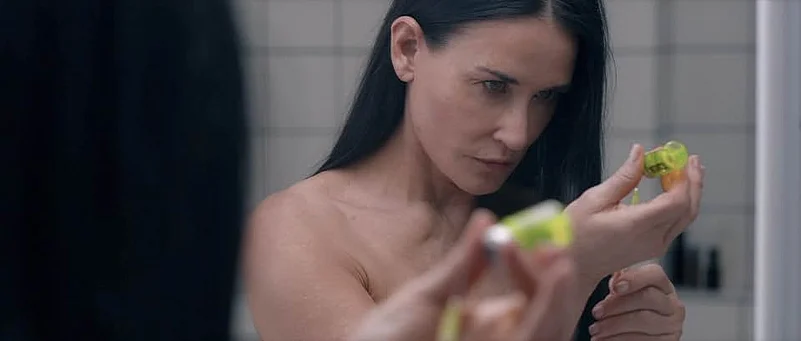In a major comeback victory, Demi Moore claimed the award for Best Actress in a Musical or Comedy at Sunday night's Golden Globes 2025 for her standout performance in the body-horror film The Substance.
Moore triumphed over formidable contenders in the category, including Karla Sofía Gascón for Emilia Pérez and Cynthia Erivo for Wicked, both considered strong frontrunners. Accepting the award, Morre said: “A few years ago, I thought this was it—maybe I’d done what I was meant to do. Then this magical, bold, courageous, out-of-the-box, absolutely bonkers script called The Substance landed on my desk, and the universe told me, ‘You’re not done,’”
In this context, here is Outlook's review of The Substance and Demi Moore's stunning performance:
Writer-director Coralie Fargeat wields style with such pronouncements that it drowns out everything else in The Substance. All the ideas in her film feel like they are running on low energy. Therefore, they have to be propped up by a whole host of provocative imagery—seemingly designed purely to test your appetite. However, you wonder how far Fargeat is capable of stretching her conceit. The film is about ageing—the feeling of disposability as one grows older, and the deepening fear of being consigned to irrelevancy and outmodedness. Once the centre of love and attention, how does one reconcile with being pushed off the altar? How to cope with the looming prospect of replacement?
In a culture that prioritises unrealistic standards of youthfulness, the film demonstrates how these notions of self-worth ultimately turn the knife inwards—corroding everything that one may believe about themselves. Desirability becomes a rat race, sucking the young and the old into a vortex of crushing expectation and envy. No one is spared. As Fargeat emphasizes, the victors are only men: leering, greedy men, desperate to cash in on toxic consumerist fantasies. Much of the damage that Elizabeth Sparkle (Demi Moore, glorious and achingly vulnerable)—an actress past her prime—suffers is not just what she overhears but also internalises to a point of no return. In The Substance, Elizabeth is an Oscar winner, but her glory days have dwindled ages ago. Crushing loneliness now envelops her. She is the face of an aerobics show for a television channel. That too—she discovers by accident—is about to get struck out. The television executive Harvey (Dennis Quaid dialling up a brand of gleeful nastiness) wants someone “young”, “hot” and of the “now”. The final knell on Elizabeth’s public life is sounded.
In the throes of rejection and heartbreak, she stumbles across a mysterious undercover drug— a titular product which holds a seductive promise of discovering the “perfect version” of herself.
There are several caveats, though. She must remember that she herself is the matrix. There’s no question of separate entities, despite the seeming disparity. “You are one”-this is the prevailing note of cautionary insistence. Finally, every seven days, she and the younger avatar, Sue (Margaret Qualley), must switch without exception.
But of course, Sue’s hooks tighten. She yearns for more. This younger self quickly starts to demand and be relentless in her aspiration. Sue’s enviable, impossible image begins eating away at Elizabeth’s faltering self-esteem. In a devastating scene, as she’s about to go out on a date, Elizabeth is struck by a billboard of Sue right outside her apartment. She gets riled at her own appearance, brutally redoing and wiping off her face. We see her almost mauling her face off.

With her perfectly chiselled physicality and unfailing bright smile, Sue emerges as the go-to of the same show that discards Elizabeth. The film becomes a tussle between the two, each exerting primacy and individuality. Bitterness and resentment are mutually lobbed—each incensed at the other for taking up too much time and space. Both turn indifferent and cold to the ominous reminders that they are one; not independent entities with functional, flourishing sexualities. The burden for a tweak in physicality, slight to major, has to be borne by both.
The central undoing of the characters takes root from a shared psychosis: a delusion both have that they can defer the price of reverting to their former selves. Elizabeth becomes spiteful at Sue’s rapid ascent to celebrityhood; the latter can’t stand the former for wasting away what she feels is her time off work. What use is Sue’s rampant fame if she can’t enjoy its yields?
Inevitably, Elizabeth and Sue breach the rule of the balance which underpins the weekly switch. Fargeat delves into the hideous consequence this has for both. She abandons subtlety in favour of maximising the grotesque spectacle of body horror, which eventually explodes in the overstretched climax. The Substance is all about excess. At no point is the director interested in reining it in. One of the most plausible horrors, though, comes from its immense satiric value. The sudden, unwanted growth of a flab on Sue’s otherwise immaculately sculpted muscles sends everyone on the floor of shoot into a tizzy.
But such moments, grounded in a wider culture, come too few and far in between. Most of The Substance is narrowly absorbed in and limited to the horror, revulsion and sourness the two women experience at being stripped of beauty and desirability. Fargeat’s interrogation of the stifling gaze women are put under never strays out for all-encompassing critique. The men are either cartoonishly villainous or summarily show up.
The Substance isn’t as sharp and biting as it sets out to be. Instead, the sexualisation of the female body solely defines the ambit of the film’s critique. All the castigation gets directed at the women in the film; Elizabeth and Sue are made to go through hell. The Substance seeks to punish through a wildly accentuated style (frenzied close-ups of disfigurements and contortions) without an interest in the female body beyond the beauty and the loss.



























